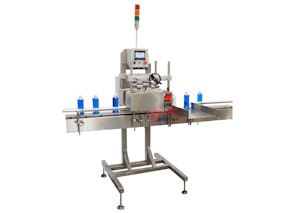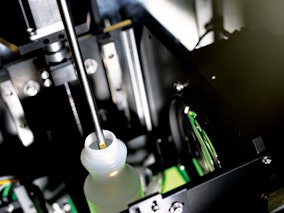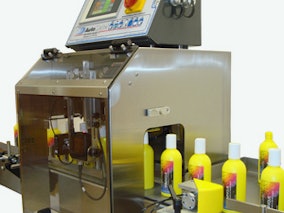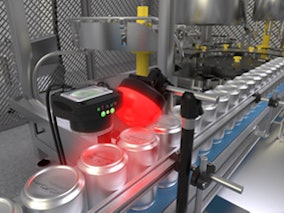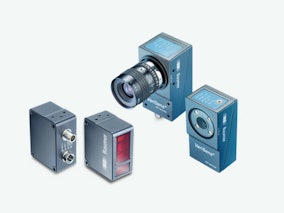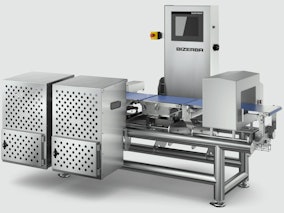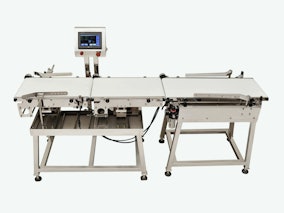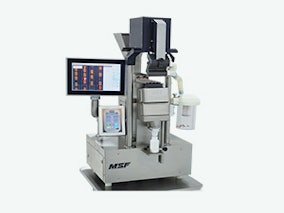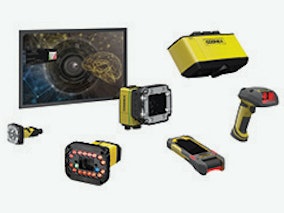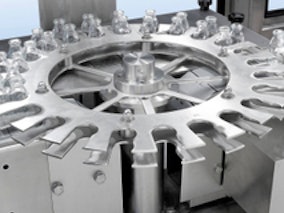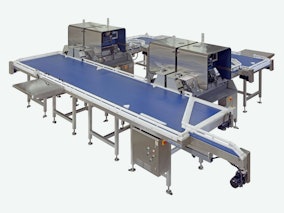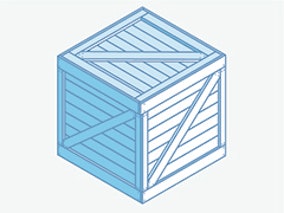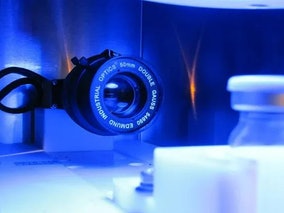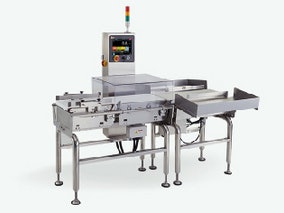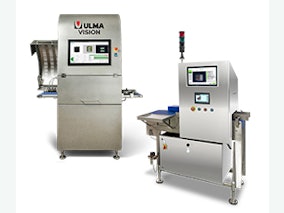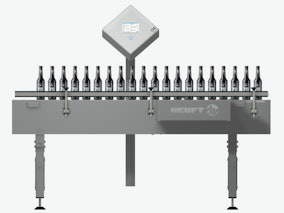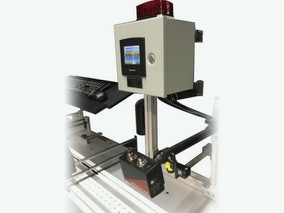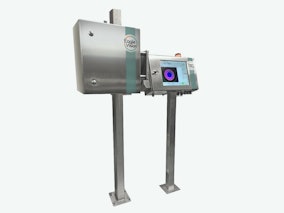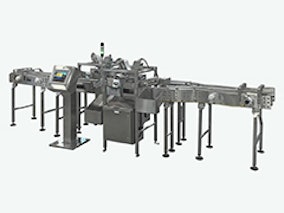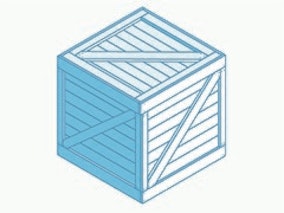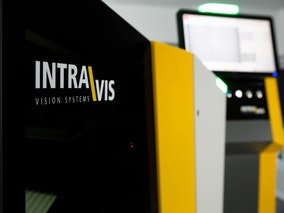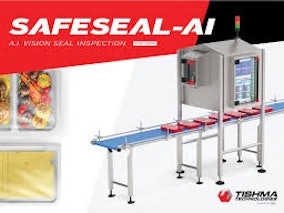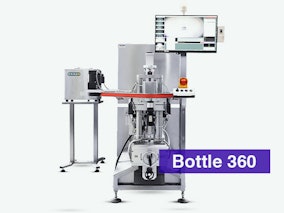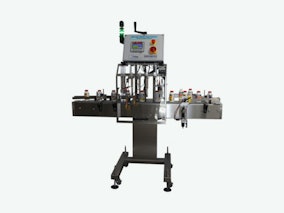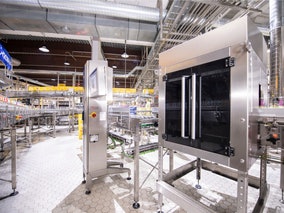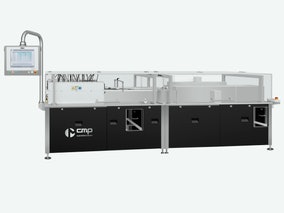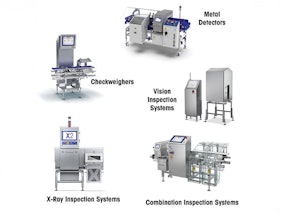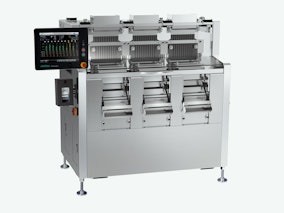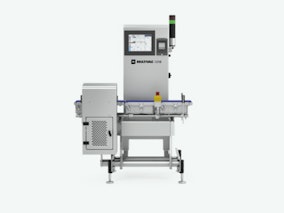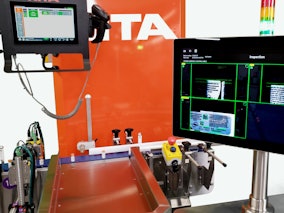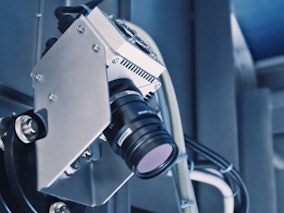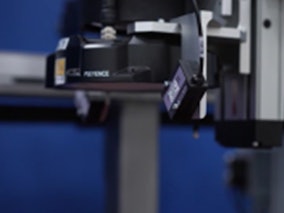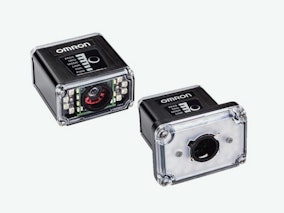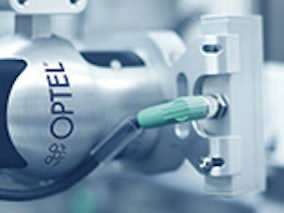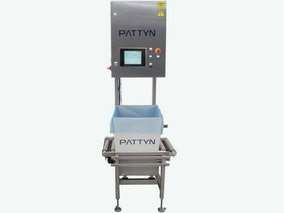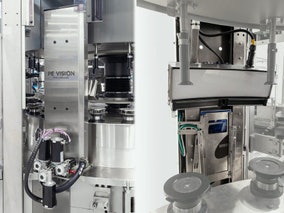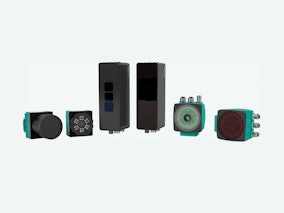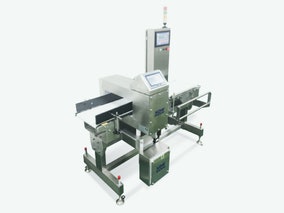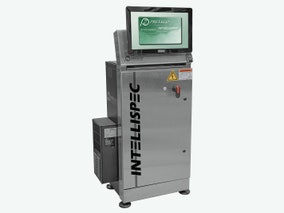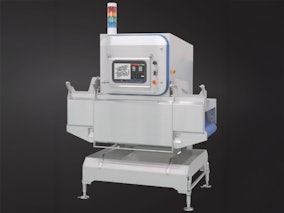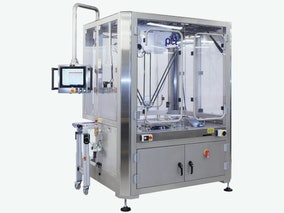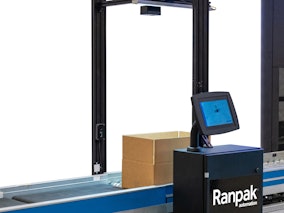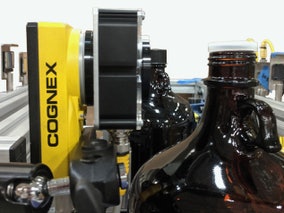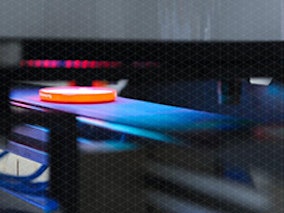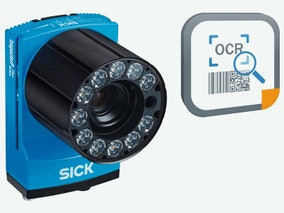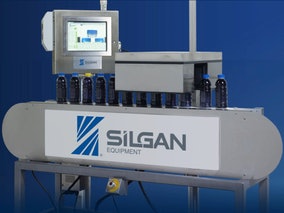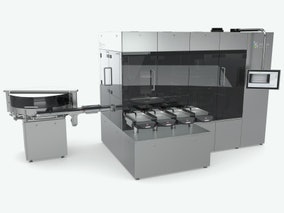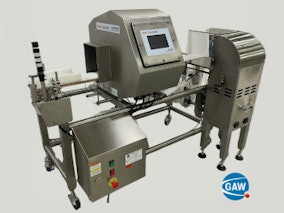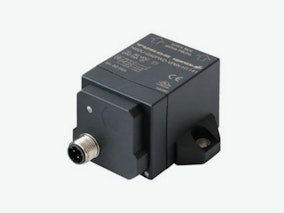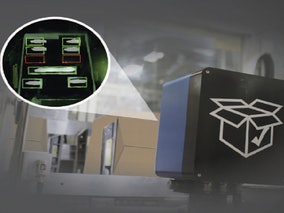Vision Inspection Systems
(57 companies)Also known as machine vision (MV), vision inspection systems use cameras and other imaging technologies to detect defects. Looking for tips and best practices on inspection and testing equipment? Explore related articles now.
-

Accutek Packaging Equipment Co., Inc.
The Accutek Inspection-Rejection Station system is designed to perform comprehensive inspections on various aspects of product packaging. It utilizes advanced technology to detect and reject containers that do not meet specific criteria. The system checks the orientation of containers to ensure they are positioned correctly, identifying and rejecting containers that are upside down or not aligned properly. The system also verifies the fill levels in containers, ensuring they meet the required standards, detecting overfilled or underfilled containers and reject them accordingly. Other applications include metal or contaminants in the product, whereby Accutek's system employs sensors or imaging technology to identify the presence of metallic objects, contaminants or foreign substances in the product. The system also examines the placement and alignment of caps on containers for skewed caps, missing caps, missing foil liners, crooked or missing labels.
You are currently not logged in -

AGR International, Inc.
Agr offers a variety of quality and process control equipment designed to meet the needs of container manufacturers, fillers and beverage companies. Agr's line of products to test glass, plastic, aluminum and other containers includes handheld thickness probes, fill height testers, dimensional sampling gauges, topload testers, impact testers, height gauges, line simulators, digital balances and many other online, lab, and manual gauges and instruments.
You are currently not logged in -

Antares Vision Group
Antares Vision offers a wide range of innovative visual inspection systems to detect defects on high speed, automatic lines for pharmaceuticals, medical device, cosmetics, beverage and food packaging lines. Systems detect package, product and label integrity, as well as label print consistency, label position consistency, and seal application. Systems provide the complete visual inspection of production line sample checks, cosmetic imperfections, print quality and product consistency to ensure the reliability of production processes for complete consumer safety.
You are currently not logged in -

Auto-Mate Technologies LLC
AutoMate supplies the industry with two bottle and packaging inspection systems: the AM-QC and the AM-DA Diagnostic Center. Model AM-QC provides product quality assurance, accuracy and integrity in one centralized machine, performing inspection tasks such as torque monitoring; detection for missing caps, missing or skewed labels, missing neck bands and foil seals; bar code verification; color correctness; conveyor speed monitoring, crooked/ loose cap detection; date/lot verification; verification of cotton placement and more. The AM-DA provides inspection and quality assurance through non-contact, non-destructive testing, with reject systems that gently remove products.
You are currently not logged in
-

Banner Engineering Corp.
Sensors and smart cameras from Banner Engineering are able to quickly inspect packages for defects. Sensor equipment includes photoelectric, registration mark, color and luminescence sensors, radar sensors, ultrasonic, as well as temperature and vibration sensors. Smart cameras include the VE high-resolution vision camera and barcode reader. All of Banner’s sensors and smart cameras set themselves apart by being easy to set up, teach, and deploy. Banner Engineering also provides lighting, vision lenses, and software for inspection applications. Contact an application engineer today for assistance with an inspection application.
You are currently not logged in -

Baumer Ltd.
Baumer Ltd.’s Smart Vision packaging inspection systems deliver high-speed, reliable quality control for manufacturing lines. Featuring advanced cameras and lighting technologies, these machine vision-based solutions inspect bottle caps, labels, fills, seals, and codes with precision and flexibility. Modular designs allow easy integration and scalability—from single-point checks to full-line systems—while customizable illumination options enhance contrast for various materials and surfaces. Powerful image-processing algorithms enable seamless detection of defects such as misalignments, missing components, print errors, and seal integrity issues. With intuitive software interfaces and remote diagnostics, Baumer’s inspection equipment supports rapid setup, efficient recipe changes, and proactive maintenance, with the goal of improved throughput, reduced waste, and enhanced compliance with industry standards.
You are currently not logged in -

Bizerba USA, Inc.
Bizerba USA is an original equipment manufacturer of a broad range of packaging inspection equipment, including checkweighers, metal detectors, X-ray systems and vision inspection systems. Featured inspection systems include the CWFmaxx line of checkweighers, mainly used in food processing companies who have to meticulously clean their systems. The stainless steel housing is suitable for use in hygienic environments. All components are easy to access, so that they can be thoroughly cleaned. The shape is designed to prevent the accumulation of dirt.
You are currently not logged in -

CAM Packaging Systems
CAM Packaging Systems manufactures the C-CW320 checkweigher, designed to provide rapid and precise weight measurements of product or packages, maintaining consistency by integrating with metal detectors or X-ray machines and offering multiple reject system options. The C-MD2030 metal detector detects and rejects metal-contaminated products, ensuring only safe items proceed through production. Designed for seamless integration, these systems enhance quality assurance and uphold stringent safety standards in packaging operations.
You are currently not logged in
-

Capmatic Ltd.
The Countlab tablet vision inspection system is an advanced solution designed to detect discrepancies in tablets, ensuring quality control. It identifies color, size, and broken tablets with precision, optimizing the production process.
You are currently not logged in -

Catalyx
Catalyx's AI-powered machine vision systems are designed to improve efficiency, accuracy, and productivity in packaging inspection across various industries. These systems support automated vision inspection, process control, robotic guidance, object detection, barcode reading, color verification, defect detection, optical character recognition (OCR), part verification, sorting, and traceability. Tailored to meet specific business needs, they can function as turnkey solutions or integrate with existing processes. Catalyx collaborates with partners like Cognex to implement machine vision technology that enhances quality, precision, and operational efficiency. By reducing errors and optimizing production, these systems contribute to more reliable and consistent packaging outcomes.
You are currently not logged in -

Cognex Corporation
Cognex machine vision systems help companies improve product quality, eliminate production errors, lower manufacturing costs, and exceed consumer expectations for high quality products at an affordable price. Typical applications for machine vision include detecting defects, monitoring production lines, guiding assembly robots, and tracking, sorting and identifying parts. Product line includes Cognex In-Sight® 2D machine vision systems, 3D machine vision tools. vision software, Cognex Deep Learning technology and barcode readers.
You are currently not logged in -

Cozzoli Machine Company
Cozzoli Machine Company is a supplier of checkweighing equipment used for containers in pharmaceutical applications, inspection equipment used in cleanrooms and more. Bottle checkweigher, which can be supplied for new or existing filling lines, uses magnetic force restoration type weighing technology for high-speed, high-precision handling of up to 200 containers per minute. Inspection machines are compact, standalone units that are ideal for use in areas with space limitations, designed with class 100 clean rooms in mind. Inspection systems handle speeds of more than 600 containers per minute.
You are currently not logged in
-

Dabrico, Inc.
The DI-100 LT/XL Inspection System is designed to perform visual inspections of vials, ampoules, syringes, and cartridges, minimizing product handling. It handles a wide range of container types and sizes, with a maximum operating speed of 150 pieces per minute. Using one DI-100 LT/XL machine, one operator can achieve the same productivity as 4-5 operators in a typical manual inspection process. For ampoules, it can inspect fill level, ampoule tip, cracks, and scratches on the ampoule body. On cartridges, it inspects cake surface (for freeze-dried products), fill level, aluminum cap crimping and dents, stopper presence, and more. It also checks for fill level, cake surface, stopper presence, cracks, and scratches on vials, as well as other anomalies.
You are currently not logged in -

Engenesys, LLC
EnGenesys offers tailored machine vision systems that integrate 2D, 3D, barcode, and AI-based technologies to ensure products meet specifications at every stage of production. These vision inspection systems are capable of detecting defects, verifying part presence, performing measurement and gauging, and reading both 1D/2D barcodes and characters via OCR/OCV. Designed to replace multiple traditional sensors, EnGenesys handles challenging applications—including variable parts, complex assemblies, and deep learning–driven anomaly detection—and supports both stepped and continuous-flow processes across industries such as manufacturing, food & beverage, consumer goods, and automotive.
You are currently not logged in -

Flexible Vision, Inc.
Flexible Vision offers advanced machine vision solutions tailored for food packaging inspection. Their technology helps detect common issues such as label damage, placement errors, defects, liquid coloration variance, and even contamination. By using AI-powered systems, they ensure precise inspection of seal integrity, liquid levels, and overall packaging quality. These solutions improve efficiency and accuracy in quality control processes, reducing waste and ensuring compliance with safety standards. Flexible Vision’s systems can be seamlessly integrated into production lines, allowing real-time monitoring and automated inspection without the need for extensive programming or manual oversight.
You are currently not logged in -

FP Developments, Inc.
FP Developments offers engineering, design, manufacturing, and service, specialized in automation for inspection systems for the pharmaceutical industries. FP will engineer automated and semi-automated inspection machines that handle integrated weight verification, conveyor paced inspection, vial/ampoule and syringe inspection and more. FP Developments inspection systems are applicable for particulate, cosmetic, stopper, cap, and defective container inspection on a line.
You are currently not logged in
-

Grupo Empac SA de CV
Grupo Empac distributes a wide range of metal detectors and checkweigers from Tecni Pac, including TECNI PAC® model TSR 600300, designed to detect the presence of ferrous, non-ferrous and stainless steel metallic contaminants in packaged products.
You are currently not logged in -

Harpak-ULMA Packaging, LLC
Harpak-ULMA Packaging's vision systems include inspection systems for tray sealed packages and thermoformed packages, as well as metal detectors. All systems are meticulously designed to enhance production efficiency, ensure compliance, and provide reliable, intuitive, and efficient inspection processes for a diverse range of packaging applications. ULMA Vision vision inspection system performs reliable, efficient film, print and bar code inspection for thermoformed food and medical devices, whether inline or as a standalone inspection unit. The G. Mondini Neural Vision Inspection system is an integrable or stand-alone machine that performs non-destructive inspection of skin packs at high throughput via deep learning algorithms that allow qualitative inspections at high speed, accuracy and reliability.
You are currently not logged in -

Heuft USA, Inc.
Heuft USA, Inc. manufactures a full line of inspection equipment for products as well as for full or empty containers used in the food, beverage, and pharmaceutical industries. Highlighted equipment at the Heuft website includes the HEUFT ONE, an entry-level detection system for checking full beverage containers in a confined space. The system detects and evaluates bottles for precise fill level, closures, labels, and other criteria. Heuft inspection systems for empty food containers include the HEUFT canLine II, which detects faulty cans before they are filled and rejects them before they can affect the productivity of complete food lines and the safety of the end product. HEUFT eXaminer II XB for pharma applications features pulsed X-ray technology that can detect minute foreign particles, bent hypodermic needles, incomplete or incorrectly packaged tablets, as well as quality defects in containers, syringes and blister packs.
You are currently not logged in -

HSAUSA
HSAUSA, a PMMI member, supplies barcode and vision inspection systems designed to easily integrate with any serialization packaging line. Machines include the BSC-350 barcode scanner controller which controls up to two bar code scanners/verifiers. Provides 100% inspection of 1D or 2D Barcodes, dependent on type of scanner or imager connected. Teach the controller with a handheld scanner, and the scanned codes will be confirmed against the taught code. If any “no read” conditions occur, the system can be setup to track and reject the printed or labeled case.
You are currently not logged in
-

Industrial Physics
Industrial Physics provides test and inspection solutions from the biggest global brands in packaging inspection, including vision systems and can integrity testers. Featured brands and solutions include the Metal Ends Inspection system from Eagle Vision Systems, which inspects damages, roundness and compound on metal can ends. Other suppliers presented by Industrial Physics include Quality By Vision, who make can-end inspection and aerosol vision inspection systems. Also highlighted on the Industrial Physics website is offline can seam inspection and measurement systems from CMC-Kuhnke.
You are currently not logged in -

Integrated Packaging Machinery
IPM's vision inspection systems for packaging inspection use barcode readers including side view cameras, overhead cameras, remote control panel, and an automatic reject system. The position and number of cameras implemented is designed for system redundancy, meaning that each barcode gets read at least twice as it travels through the inspection zone, minimizing false-positive rejections. If a problem is detected, such as a wrong barcode or a misread (no read), the system automatically pushes the questionable product into a manual inspection bin.
You are currently not logged in -

Integrated Packaging Systems
IPS slat counters can easily be integrated with Optel Vision Systems – CountSafe™ inspection system for greater assurance that the correct product and correct count are placed in each bottle for tablet and capsule inspection applications. CountSafe inspection system ensures that bottles are filled with 100% correct products; system inspects tablets, capsules, gel caps, dual colored capsules and dual colored tablets. Increased accuracy helps to avoid costly recalls and promotes an excellent ROI with less product rework and increased productivity.
You are currently not logged in -

INTRAVIS Inc.
INTRAVIS makes vision systems for the inspection of plastic bottles and containers, caps, preforms, decorated/labeled packages, and barrier presence. Products include the PREMON, a preform monitoring system and the LayerWatcher, designed to simplify and accelerate the inspection of barrier layers in PET preforms. Other systems include INTRAVIS’ CapWatcher series for closure inspection and the SleeveWatcher, exclusively designed for inspecting sleeve labels.
You are currently not logged in
-

IPG
IPG's Tishma Technologies brand has leveraged AI to develop an advanced in-line heat seal inspection system for the food and medical industries. By applying deep-learning A.I. vision tools to thermal images, the system detects most sealing defects—including those difficult to identify with rules-based vision tools or standard vacuum-check inspections. This PC-based, turnkey inspection system is designed to reliably inspect heat-sealed trays at speeds up to 500 PPM.
You are currently not logged in -

Jekson USA Inc
Jekson Vision manufactures an extensive line of packaging inspection machines for pharmaceutical and biopharmaceuticals, food and beverage, and other industries. Vision inspection systems from Jekson Vision include the Bottle 360 for pharmaceutical and healthcare packaging. Equipped with seven cameras, the Bottle 360 offers comprehensive helper code association and inspection. Bottle 360 boasts a modern cGMP design, meeting the highest industry standards for industry applications. Jekson also supplies BiSmart inspection machines, employing the latest in AI, ML, and deep learning technology. BiSmart is engineered to eliminate manual errors, promote increased efficiency, and ensure accuracy in meeting the stringent requirements of the packaging line. Other systems include pinhole detection systems and blister inspection systems.
You are currently not logged in -

Kaps-All Packaging Systems, Inc.
Kaps-All distributes the AM-DA Quality Control Center from AutoMate Technologies. This diagnostic inspection center allows for non-contact/non-destructive testing and rejection of containers for multiple specifications in one center. Standard features include bottle counter and rate meter module, conveyor speed monitor with encoder and alarm module, and missing cap detector module.
You are currently not logged in -

Körber Pharma
Körber Pharma supplies automatic inspection engineered for the medical and pharmaceutical applications. Whether the product is liquid, highly viscous or freeze-dried, Körber Pharma has packaging inspection equipment for syringes, vials, ampoules, cartridges, and more. Designed for the high demands that pharmaceutical and biotech products and their special containers place on transport systems, Körber equipment can inspect all areas of the package or container, including tips and caps, particles or beads on the container, crimp, stopper, neck, sidewall, and bottom. In addition, Körber inspection systems perform leak detection and needle/shield detection. Systems feature Körber's Eject-X, a deep-learning feature that trains all cameras and inspection stations.
You are currently not logged in
-

KRONES
Krones' product line of packaging inspection equipment includes vision inspection systems, fill level inspection equipment for canning and bottling lines. Krones' Checkmat inspection systems verifies if the right bottles are in the pack and there are no foreign objects in the package, among other tasks; Checkmat label inspectors also available. The Linatronic AI offers empty-container inspection technology for glass and PET containers with deep learning capabilities. ModulCheck is designed for operations with limited space or when only a single inspection is required.
You are currently not logged in -

Marchesini Group USA Inc.
Marchesini Group USA offers leak testing equipment as well as glass and plastic bottle inspection systems.
You are currently not logged in -

METTLER TOLEDO
Mettler Toledo’s broad range of product inspection systems includes checkweighers, metal detectors, x-ray inspection systems, track and trace systems, vision inspection, and more. Systems are made for all types of bulk and packaged products for environments ranging from dry to harsh wash-down and can detect solid contaminants, verify product weights, mark and verify packages, ensure accuracy and integrity of packaging and labels, confirm component content, inspect closures, and measure fill levels.
You are currently not logged in -

MG America, Inc.
MG America is a supplier of high-precision checkweighers, metal detectors, and vision inspection systems, designed for pharmaceutical, medical, and nutritional processing and packaging applications. Capsule checkweighers provide 100% weight verification with models handling up to 230,000 capsules per hour with ±0.5 mg accuracy, featuring compact designs, overload protection, and GMP compliance. The SELEKTA high-speed checkweigher/sorter verifies up to 200,000 units per hour and integrates seamlessly with tableting equipment. For vision inspection, the TCI Tablet & Capsule Vision Inspection Machine inspects up to 300,000 units per hour, detecting defects such as cracks, chips, and discoloration to ensure quality control. These systems enhance production accuracy, efficiency, and regulatory compliance.
You are currently not logged in
-

MULTIVAC Group
Multivac’s inspection solutions cover three key equipment categories: checkweighers, visual inspection systems, and X-ray and metal detection units. Checkweighers ensure accurate product weights and can include integrated metal detection for added safety. Visual inspection systems use sensors, code readers, and cameras to verify label accuracy, seal integrity, and detect packaging defects. X-ray and metal detectors identify both metallic and non-metallic foreign objects, such as glass or stones, helping manufacturers meet strict food safety standards. All three systems are designed for seamless integration into automated packaging lines, supporting high throughput, quality control, and compliance with international regulations and retailer requirements.
You are currently not logged in -

Nita Labeling Systems
Nita offers advanced Cognex vision and product tracking Systems designed for seamless integration into its Sentient Labeling Machine or as a standalone solution. With capabilities such as Optical Character Recognition (OCR) and Optical Character Verification (OCV), they enhance quality control by detecting label height, skew, and presence while also enabling serialization and rejection mechanisms. Engineered for high performance, these vision systems help maintain consistent product integrity, reducing errors and ensuring compliance with industry standards for packaging and labeling applications.
You are currently not logged in -

Niverplast NA Inc.
Niverplast's Quality Checker is an advanced camera-based inspection system designed to ensure products meet specific quality standards for bag-in-box, bagging, sealing, and related operations for bakeries and other industries. Capable of handling up to six channels simultaneously, it allows for the inspection of multiple products concurrently. The system evaluates various attributes, including dimensions (length, width, height, and roundness with 2 mm accuracy), browning levels, and the presence of black spots. Equipped with up to eight retractable, servo-driven belts, the Quality Checker facilitates precise rejection of non-conforming products. Its user-friendly interface, featuring an interactive touchscreen, simplifies operation, adjustment, maintenance, and cleaning. Constructed entirely from stainless steel, the system ensures durability and hygiene, making it suitable for continuous production environments. Integration with Niverplast's software enables seamless data management and quality control.
You are currently not logged in -

Norwalt
Norwalt offers turnkey inspection systems utilizing 2D and 3D vision and laser inspection for pre- and post-assembly verification. Integrated vision systems can go into any assembly and serve industrial needs through deep machine learning. As part of its reject verification system, Norwalt’s vision system capabilities include: defect detection, AI assisted Inspection, 3D Inspection, fill height, product shape and more.
You are currently not logged in
-

Omron
Omron Industrial Automation's comprehensive machine vision hardware line includes industrial cameras, vision systems and smart and PC-based cameras that are scalable across software platforms. Portfolio offers compact form factors for tight spaces, high-speed imaging for fast-moving production lines, and high resolutions for detailed inspection. Featured systems include the MicroHAWK F430, representing the next generation of Omron’s popular MV-40 model. Featuring the smallest IP65/67-rated, true industrial Ethernet smart camera now with expanded functionality, Omron Microscan's machine vision tool is designed for solving multiple vision inspection challenges.
You are currently not logged in -

Optel Group
Optel supplies machine vision systems for the pharmaceutical industry, designed to ensure quality and safety. Offering more than 60 features for inspection categories, Optel's equipment covers product inspection (unit dimensions, shape, color, etc.), packaging inspection (integrity, seal, inserts, cap and tamper-evident seals), as well as labeling and printing (label presence, orientation, print positioning and quality, etc.) Featured systems include OPTEL’s InspectProof, a flexible automated vision system that provides extensive inspection of labels, cartons, trays, devices and cases at rates of up to 2,000 ppm.
You are currently not logged in -

Oxipital AI
Oxipital AI’s end-to-end visual AI solutions for inspection seamlessly integrate into manufacturers’ existing workflows without process disruption or upstream product presentation requirements. Oxipital AI vision works together with a pre-trained object model to quickly capture product images and accurately identify key product attributes. The images are analyzed in real-time to recognize patterns, anomalies, and deviations, flagging those that don’t meet desired quality standards. User-friendly dashboards present the inspection data and product images allowing process engineers to uncover troubled areas in the production line and make data-driven process changes. These actionable insights enhance yield, reduce waste, and improve product quality.
You are currently not logged in -

Pattyn, A Duravant Company
Pattyn North America’s quality control equipment include machine vision systems for processing applications and the CW-11 check weigher, which weighs boxes to check if the weight is situated between the set limits. Available with a reject conveyor, the check weigher uses a roll conveyor instead of a belt so that the box will be rejected in the same position. Standard check weigher handles up to 12 c/min, while a continuous check weigher handles higher speeds above 12c/min.
You are currently not logged in
-

P.E. Labellers
P.E. Labellers offers vision systems with cameras or smart cameras for container orientation with maximum precision even at high speeds. Qcheck solutions installed at the outfeed check for the presence and correct position of applied labels to ensure the highest quality standards. The same cameras can also be used at the infeed to check the filling level, the presence or absence of the cap or the color of the product inside a transparent bottle.
You are currently not logged in -

Pepperl+Fuchs, Inc.
Pepperl+Fuchs offers vision sensors and vision systems for every requirement in industrial vision. The comprehensive portfolio ranges from universally applicable sensors to application- or customer-specific products to turnkey solutions, always with the goal of ensuring reliable image processing.
You are currently not logged in -

PPi Technologies Group
PROFILE Packaging and PakSource Global offer a full range of checkweighers including metal detectors and combination metal detectors/check weighing systems as well as a full range of X-ray machines for both flexible and ridged packaging.
You are currently not logged in -

Pressco Technology Inc.
Pressco's INTELLISPEC platform provides high-speed inspection of various packaging components such as preforms, empty bottles, filled bottles and closures. The modular system architecture allows for multiple distributed inspection points, all controlled from a single processor. Pressco systems inspect parts at line speeds in excess of 3,000/minute.
You are currently not logged in
-

Prospection Solutions
ProSpection Solutions offers metal dection and X‑ray inspection systems designed to detect foreign contaminants and verify package integrity across food, medical, and manufacturing lines. Dual‑energy systems combine high‑resolution sensors with artificial intelligence to identify items such as glass, hard plastics, and ceramics, even within opaque or multi‑layer packaging. Integrated optical imaging overlays enable comprehensive seal inspection and defect detection through printed or metal films, supporting real‑time data analytics, traceability, and production line optimization.
You are currently not logged in -

PTI - Packaging Technologies & Inspection
PTI offers testing equipment to ensure container closure integrity for the pharmaceutical, medical, food and beverage, and other markets. Wide range of testing equipment tests packaging formats including vials, ampoules, syringes, autoinjectors, blister packaging, induction sealed bottles and flexible packaging (pouches, sachets and suture packaging). Featured testing equipment includes Seal-Scan® and Seal-Sensor utilizing non-contact airborne ultrasonic testing technology, VeriCon inspection systems for bottle and container leak testing and VeriPac Vacuum Decay Series of inspection systems.
You are currently not logged in -

Ranpak
Ranpak’s DecisionTower™ is an automated quality inspection system that uses AI and machine vision to detect out-of-scope boxes or cases, which both optimizes packing and prevents machine stops to help customers realize better ROI for packaging and e-commerce order fulfillment sectors. It can perform checks for problems such as box overfill, box size, box orientation, empty box, void level measure, flap angle, and more. The system not only reduces reliance on end-of-line operators for quality control, but also captures data to prevent future errors from rough handling or faulty packaging. DecisionTower uses AI to maximize equipment uptime, customizing processes for businesses.
You are currently not logged in -

Remtec Automation, LLC
Remtec’s continuous and intermittent motion product vision inspection systems run at rates up to 200 per minute. Applications include bottle inspection. Robotic vision inspection technology offers businesses of all sizes a dependable solution for quality control issues. Innovative robotic vision inspection technology also offers the advantage of increasing productivity through optimized process up time, elimination of quality slips, and reduced rework. Robotic vision inspection systems are adaptable as product designs change over time.
You are currently not logged in
-

SACMI USA Group
SACMI's know-how and experience for the control and machine vision systems dates back to 1987. SACMI offers a comprehensive range of products and technologies for quality and process controls, including machine vision systems for closures, preforms, containers, capsules, beverages, metal packaging and more. Featured packaging inspection systems include the CONTCHECK-360, which has seven high-resolution cameras that enable inspection of all the features of the container, including walls, mouth and bottom. THe CVS102 system for inspection of plastic screw caps runs at a speed of up to 360,000 caps per hour. SACMI’s LABELCHECK-360 carries out the quality control inspection of jar labelling and seaming.
You are currently not logged in -

SICK, Inc.
SICK’s machine vision systems are engineered for automated inspection and measurement tasks. Using photoelectric sensors, SICK vision systems handle tasks such as error proofing and optical character recognition (OCR) for labels. SICK offers 2D vision, 3D vision options.
You are currently not logged in -

Silgan
Silgan is an original equipment manufacturer of closure and label vision inspection systems designed to monitor production quality to optimize performance and productivity on bottling and capping lines. Machines feature sensor-based and multi-camera 360° inspection technology and handle speeds up to 800 containers/minute. Silgan also makes the 2D Profiling Dud Detector for inspecting lug, PT or composite cap-sealed for cap application and proper vacuum levels.
You are currently not logged in -

Stevanato Group
Stevanato Group Engineering offers automatic, high-speed inspection equipment for applications including high-value drugs, viscous drugs, foaming liquids or lyophilized products filled in a variety of glass containers including ampoules, vials, cartridges and syringes at speeds up to 36,000 units/hour. Available inspections include particle, cosmetic, fill level, tip/cap and alu seal control, plunger for cartridges and syringes, integrated leak detection, and closure integrity inspection.
You are currently not logged in
-

TDI Packsys LLC
TDI Packsys LLC manufactures a comprehensive range of inspection systems designed to ensure product quality and detect contaminants across industries. Their offerings include metal detectors for identifying metallic impurities during processing; X-ray inspection systems that detect a broader range of foreign materials such as glass, bone, and plastic; and vision inspection systems that automate quality control, reducing human error and improving consistency. TDI Packsys also fabricates checkweighers, color sorters, rejection systems, separation and orientation systems and related products to enhance operational accuracy by arranging products during downstream processing. TDI’s systems are customizable, integrating advanced components that meet specific operational needs, whether for high-speed environments or stringent hygiene standards. All solutions are designed to deliver robust quality control while optimizing efficiency and minimizing waste.
You are currently not logged in -

Tessera Group Inc.
Tessera Group's MD Packaging brand supplies packaging inspection systems supplied by Thermo Fisher Scientific and meticulously personalized in-house by the group's George A. Wright brand, including system design, conveyor design, integration, and controls. MD Packaging is dedicated to improving product safety standards and operational excellence through its wide selection of product inspection and safety packaging equipment, including x-ray systems, metal detectors, check weighers, and combination units.
You are currently not logged in -

Turck Inc.
Turck manufactures sensors and related equipment used in fill level detection, cap detection and related applications. Featured products include the rectangular uprox+ sensors, designed to reliably detect bottle caps. Between high-speed overrun, different types of metals, high demands on tightness, and mechanical robustness, the reliable detection of bottle caps can be a very challenging task for inductive sensors. Turck's Uprox+ sensors with the one-piece rectangular housing (design QT42) in protection class IP69K have been developed specifically for these demanding applications.
You are currently not logged in -

Valco Melton
The PackChek® System for hot melt inspection in end-of-line packaging applications uses both thermal and visual imaging to inspect the heat signature of the package to ensure hot melt glue has been applied to the correct locations.
You are currently not logged in
Report an Issue
Incorrect/inaccurate categorization? Report inaccuracies or problems »
Related Packaging Inspection Equipment searches
More on Vision Inspection Systems
Vision Inspection Systems, also known as machine vision or MV systems, use cameras and other imaging technologies to detect defects in products. These systems are used in various stages of the production process, from inspecting raw materials to final packaging. The use of MV systems not only ensures the quality of products but also increases efficiency and reduces costs.
One of the common use cases for MV systems is in the inspection of packaging materials. These systems can detect defects such as wrinkles, tears or misalignments in packaging materials. They can also check for the correct labeling, printing and barcodes on the packages. This ensures that the packaging maintains a high quality and meets the required standards.
MV systems are also used in the inspection of products themselves. For example, in the food industry, they can detect foreign objects such as metal, glass or plastic in food products. They can also check for the correct size, shape and color of the products. This ensures that only safe, high-quality products are sent to stores.
Another use of MV systems is in the inspection of production equipment. This technology can detect wear and tear on equipment, which can help prevent breakdowns and reduce downtime. They can also detect improper assembly or alignment of equipment, which can lead to defects in products or safety issues.
The use of MV systems has several benefits that apply directly to the packaging and processing industries. First, they ensure the quality of products, which can lead to increased customer satisfaction and loyalty. Secondly, they increase efficiency by reducing the need for manual inspections, which also increases the speed. Lastly, they reduce costs by preventing defects and reducing downtime.
There are several types of MV systems available in the market, each with its own set of advantages and disadvantages. One type is the area scan camera, which captures a two-dimensional image of the object being inspected. Another type is the line scan camera, which captures a one-dimensional image of the object as it moves past the camera. A third type is the 3D camera, which captures a three-dimensional image of the object.
MV systems can also use different types of lighting, such as bright field lighting, dark field lighting and backlit lighting. The type of lighting used depends on the type of defect being inspected and the properties of the object being inspected.
To conclude, vision inspection systems are an essential tool in the packaging and processing industries, amongst others. They help ensure the quality and safety of products, increase efficiency and reduce costs. With various types of MV systems and lighting available, industries can choose the best system for their specific needs. The use of MV systems is only expected to grow in the future as industries continue to prioritize quality and efficiency, and automation becomes more standard.
You can find vision inspection systems from high-quality, reliable suppliers and manufacturers right here on PMMI’s ProSource directory. Get started today.
